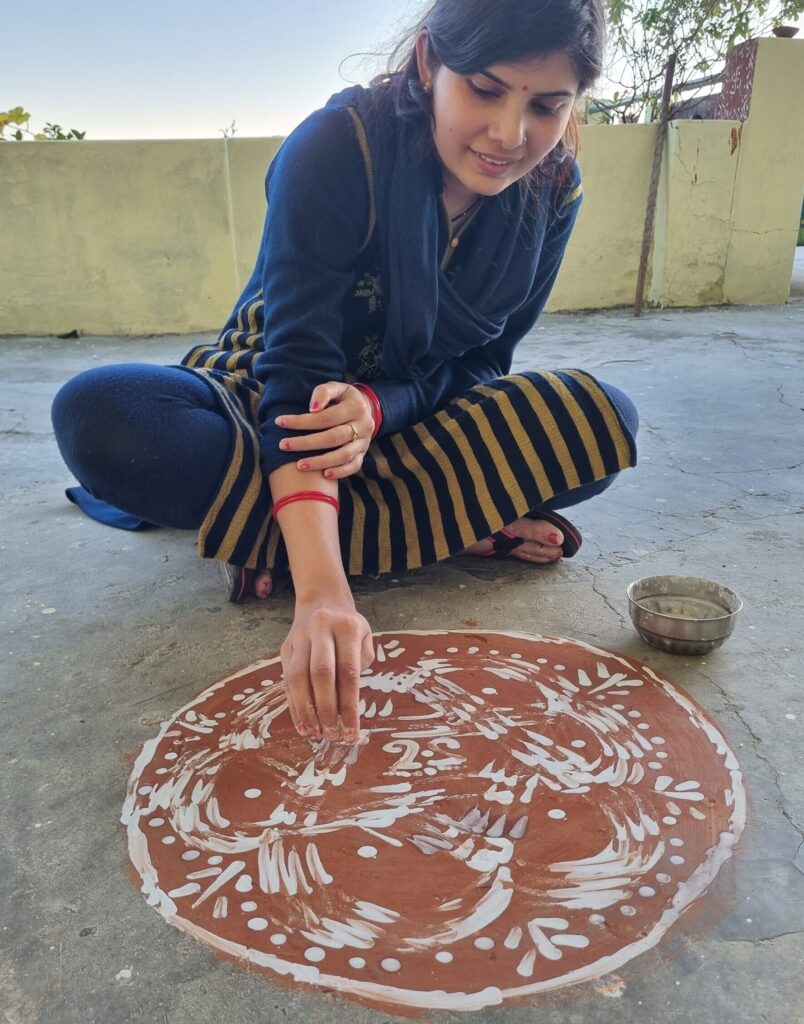Introduction
Art has always been a powerful way to express and preserve culture. Aipan is a unique folk art from Uttarakhand, a beautiful state in the Himalayas, India. Aipan art holds great significance for the people of Uttarakhand, reflecting their beliefs, rituals, and traditions. In this blog, we will explore the captivating world of this art, its origins, symbolism, techniques, and the enduring cultural heritage it represents
Origin of Aipan art
Aipan art has its roots in ancient times when it became an integral part of the Kumaoni and Garhwali cultures in Uttarakhand. The name “Aipan” is believed to have come from “Ai,” meaning mother, and “Pana,” meaning offering. Women played a crucial role in creating this beautiful art, using it to decorate their homes during auspicious occasions and festivals.

Symbolism and Themes
Aipan art is rich in symbolism and carries deep spiritual significance. The motifs in Aipan designs often depict nature, deities, and religious symbols. They include the sun, moon, birds, flowers, geometric patterns, and various forms of deities such as Lord Shiva, Lord Ganesha, and Goddess Lakshmi.
Each motif holds a specific meaning and is believed to bring good luck, ward off evil spirits, and bless the household. For example, the swastika symbolizes prosperity, while the lotus signifies purity. The peacock represents grace and beauty, and the serpent symbolizes protection. These motifs are arranged in a harmonious and symmetrical manner, creating intricate patterns.
Techniques and Materials
Creating this beautiful traditional art requires skill, patience, and precision. Traditionally, Aipan designs were made on the floor using a rice flour paste called “Rangoli.” Nowadays, artists use natural pigments like turmeric, vermillion, and charcoal, as well as commercial paints, to add vibrant colors to their art.
The process starts with drawing a basic grid pattern using white pigment. Artists then use their intuition and creativity to fill in the designs within the grid, expanding the motifs outward. The designs often have symmetry, with mirror-like images on each side of the central motif. This process involves careful measurements, freehand drawing, and attention to detail.
Preserving Cultural Heritage
Aipan art serves as a cultural bridge, connecting generations and preserving Uttarakhand’s rich heritage. This art form has been passed down from mothers to daughters for centuries, ensuring continuity and cultural identity. It reflects the deep connection between nature and the people, as well as their spiritual reverence.
Unfortunately, Aipan art has lost popularity in recent years due to changing lifestyles and the use of modern materials. However, there is a growing effort to revive and preserve this unique art form. Workshops, exhibitions, and educational programs are being organized. Artisans are also incorporating Aipan designs into contemporary products like clothing, home decor, and accessories, giving the art form a fresh and modern appeal.
Conclusion
Aipan art is a testament to the rich cultural heritage of Uttarakhand and its people. The intricate designs, vibrant colors, and profound symbolism showcase the creativity, spirituality, and traditions of the region. By reviving and preserving Aipan art, we can ensure that future generations appreciate and continue this beautiful form of cultural expression. Let us celebrate Aipan art as a treasure that connects us to our roots and enriches our understanding of the diverse world of art.
